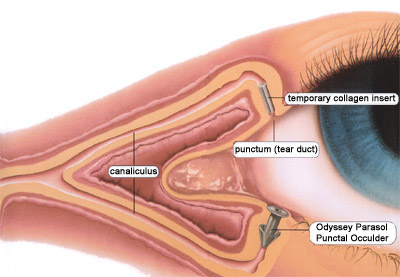Dry Eye Syndrome
Dry eye syndrome, which results from insufficient production of natural tears, is one of the most common ocular disorders treated by ophthalmologists. It affects millions of Americans each year, especially post-menopausal women.
Tears play a vital role in the proper functioning of the eye. Comprised of mucus, water, and oil layers, tears deliver moisture and important nutrients to the cornea in order to maintain its health. When the tear duct does not produce enough lubricating tears, dry eye syndrome may develop. Dry eye syndrome may also develop as a result of excessively watery eyes that produce tears without the correct balance of mucus, water, and oil.
People who suffer from chronic dry eye should seek treatment from a qualified medical professional. If left untreated, this condition may damage the cornea, increase the threat of an infection, and eventually lead to the inability to produce natural tears. In the most acute cases, this condition can impair vision.
There are two types of tears: constant tears and reflex tears. Constant tears are continuously produced to lubricate the eye at all times, and contain natural antibiotics to fight infections. Reflex tears are only produced in response to irritation, injury or emotion to help rinse the surface of the eye. A delicate balance between constant and reflex tears, in addition to a satisfactory blink reflex, helps ensure that your eyes will be comfortable, well-lubricated and well-protected.
Symptoms of Dry Eye Syndrome
Dry Eye Checklist
- Red eyes
- Itching
- Burning
- Watery eyes
- Sandy or gritty feeling
- Tired eyes
- Seasonal allergies
- Arthritis/Joint Pain
|
- Constant tearing
- Foreign body sensation
- Light sensitivity
- Occasional tearing
- Contact lens discomfort
- Dry throat or mouth
- Pain or soreness in or around eyes
|
| If you experience the symptoms above, you may be be suffering from DES. Left, untreated, your symptoms will most likely intensify, making your daily life unpleasant, or worse, deteriorate your visual acuity. If in doubt, ask your eye care specialist if the Parasol Punctal Occluder can help you. |
Causes
Aging - Tear production decreases with age. In fact, the volume of lubricating constant tears can be as much as 60% less at age 65 than 18. This reduction in constant tear flow and resulting eye irritation may cause occasionally excessive reflex tearing.
Environment - High altitudes; sunny, dry, windy conditions; and the use of heaters, blowers and air conditioners increase tear evaporations and reduce eye lubrication.
Contact Lenses - Contact lens wear can dramatically increase tear evaporation, causing irritation, infection, protein deposits, and pain. Research shows that dry eye is the leading cause of contact lens discomfort.
Medications - Some medications decrease the body's ability to produce lubricating tears. These include decongestants, antihistamines, diuretics, heart disease and ulcer prescriptions, antidepressants, anesthetics and drugs containing Beta Blockers.
How is dry eye syndrome treated?
Depending on the intensity of the condition, treatment may be as simple as using artificial tears a few times a day. Lubricating ointments and gels are also available for temporary soothing of dry eye symptoms. However, they can cause blurry vision, so use discretion when using. Most people prefer to use the ointments or gels before they go sleep at night.
In more persistent cases, however, a simple non-surgical procedure is available that provides long-term relief of dry eye syndrome through use of tiny plugs called "punctal occluders."
What are punctal occluders (plugs)?
As the name suggests, these devices occlude (block) the punctum, or tear duct, which is the drainage duct that carries tears away from the surface of the eye. There are upper and lower punctum ducts in the inner corner of each eye. Blocking these drainage ducts prevents tears from draining away too quickly. Punctal occlusion can be compared to putting a stopper in a sink drain, keeping the tears on the eye's surface for longer periods. This widely performed procedure is safe, quick, painless, and totally reversible.
In some cases, small dissolvable plugs are first inserted into the tear drainage ducts. These plugs can last up to a week before they dissolve. If you expereinece symptomatic relief during this test period, your doctor may determine that you can benefit from permanent punctal plugs.

|





